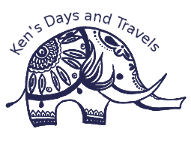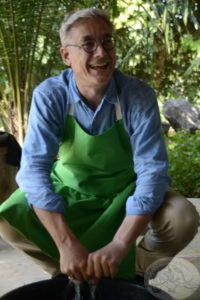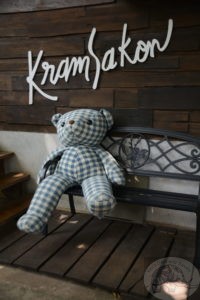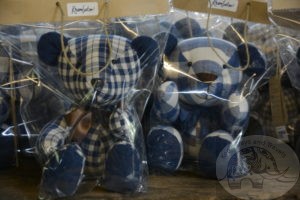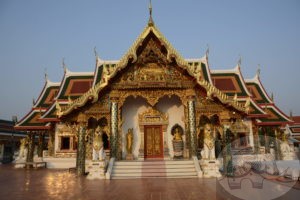Sakhon Nakorn…Indigo Fabric
Hiccup. Hiccup. Hiccup…… arghhhhh I broke one of my own rules and devoured a few of pieces of ‘mieng kham’, a delicious treat with a potent kick should it contain chili peppers. I had been standing in the evening market in downtown Sakhon Nakorn when I noticed a small stand where fresh ‘Mieng Kham’ was being prepared. I hovered for a few moments at the stand to watch the process, and was offered a taste – “that’s fine, I replied, just leave the chili pepper out”. The delectable was duly prepared as ordered, and it tasted just great. Thinking of my travelling companions, I purchased a small bag of the snack, and conveniently forgot that they had been made with chilies in them….. As I was due to fly back to Bangkok in an hour, no one had the time to taste some of the snack, and I carried it back home with me. And now, as I am writing this, I am paying for my oversight. I have a very low tolerance for spicy food, and if anything contains chili peppers, I must first eat a few spoons of rice to coat my stomach to help absorb the acid. When I don’t follow that rule, I end up with an uncontrollable case of hiccoughs. A few moments ago, feeling peckish, I devoured four of the tidbits, despite the fact that the first two set my mouth on fire and should have been a warning. Now, hiccup…hiccup…I will…hiccup… have to write this …hiccup… in fits and starts between these diaphragmatic convulsions. Perhaps drinking water while holding my breath will help.
Far removed from the centre,
Over the past 30 years, I have travelled extensively throughout Thailand, probably to nearly every province in the country (77 at last count, 72 when I first arrived). Sakhon Nakorn was actually one of the first provinces I visited during my stint as a volunteer, back in the late 1980s. I had attended some event by the Department of Livestock Promotion where I ran into another volunteer from the Netherlands who was working with an operation in Sakhon Nakorn promoting beef production and sheep farming. Getting to Sakhon Nakorn was an adventure in and of itself, with long stretches of train and bus travel, followed by even longer stretches in pick up trucks. Roads were not the best yet in the 80s, but that added to the adventure. Tucked away in the far northeastern corner of Thailand, Sakhon Nakorn was far removed from Bangkok, and life had its own pace. The language was definitely something to get used to, even for someone who had already spent a year or two learning central Thai, albeit with a Ratchaburi accent. I could write books about the dialects and languages distributed throughout Thailand, but I’ll leave that to the anthropologists and linguists, as they are better qualified to deal with that subject area.
Life has its own pace,
So my first experience was to learn about beef and sheep in this province. On a subsequent trip, about a decade later, I had an opportunity to learn about the region’s history, and the influences from Vietnamese, Cambodian and Laotian cultures, among others, on this province. This second trip was for the production of a documentary to promote tourism in the far northeast region of Thailand, including other provinces such as Roi Et, Kalasin, Nakorn Phanom and Sakhon Nakorn. We visited many of the main temples as well as archaeological sites, and covered many thousands of square miles in a 7-day tour from which I subsequently had to come up with a video script of approximately 12 minutes in length. I cannot find that script anymore, but the photographs still bring back memories. Although I have been to Sakhon Nakorn since then, it was only as I was passing quickly through the province on my way to Nakorn Phanom, as is the case with many itineraries for tourists to the region. For some reason, Sakhon Nakorn has remained off the beaten track for decades, as hordes of tourists flock to other provinces, including Udorn Thani, Khon Kaen, and Nakorn Phanom, only learning about Sakhon Nakorn as their motorized vehicles cruise along the highway through the province on the way somewhere else.
In a town not much changed
On a more recent trip, I had the opportunity to spend a few hours in the centre of Sakhon Nakorn, as well as some of the nearby villages, as we were doing research on some of the local handicraft products, and Indigo Fabric in particular. The province has a rich heritage of producing naturally dyed fabric, and over the past decade or so, the Department of Industrial Promotion of Thailand’s Ministry of Industry has worked closely with local communities and experts to promote the production of indigo fabric, from the basics of how to grow the plants that are used to create the dye, to the design and marketing of the products. Although there have definitely been changes over the past 30 years, Sakhon Nakorn is still, for all intents and purposes, a quiet, sleepy provincial capital with tree-lined streets and a relaxed atmosphere. A few minutes outside the town is what is probably one of the best restaurants in the area, Krua Lamduan, with a good selection of local dishes, including of course papaya salad, otherwise known as Somtam. Some excellent ‘gai yaang’ (roast chicken), roast pork neck (Kor Moo Yaang), and several other equally interesting and delicious choices. In the town itself, a steady stream of people makes its way to the main temple of the city, Wat Phra That Choeng Chum Worawihan.
As the evening prayers are chanted by the monks, a peaceful quiet settles over the surrounding community. On weekends, in the late afternoon, the street in front of the temple is transformed into a walking street market for mainly Indigo fabric products, some food, and even some fighting fish. Casual and comfortable, the babble and banter of the vendors perfectly suits the relaxed atmosphere, and strolling around the stands is a pleasure, unrushed, unhurried. Don’t forget to taste the Mieng Kham – hiccup!
